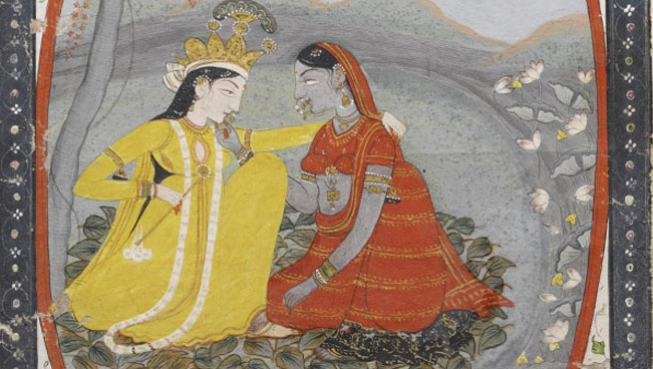Valentine's Day at the ROM: Unique Painting of Lovers

Guest blog by Sudharshan Duraiyappah, a scholar and instruction at the University of Toronto and the ROM
A cursory glance at the 17th century Kangra painting featuring Radha and her lover Krishna, who according to Hindu mythology is considered an incarnation of the god Vishnu, might elicit a double take. This miniature painting in the ROM’s collection portrays the fair – skinned Radha in her male lover’s attire and the dark- skinned Krishna wearing his female lover’s garments.
Raised in the Yadhava clan, the mischievous Krishna spent his boyhood charming the milk maids with the music of his flute. Of all the young Gopis, he came to favour Radha. Allegorically, Radha is a symbol of the human soul (atman) that always longs to unite with the ultimate universal reality (Brahman) here seen in the form of Krishna. The Radha – Krishna story make popular in the text Bagavata Purana, makes use of the human emotion of romantic love as a metaphor for the love between the devotee and the divine.
There are many Indian miniature paintings in which Radha and Krishna exchange certain items of clothing and adornments. This painting in the ROM’s collection is unique in its seemingly complete exchange of gender. The female lover, Radha is shown wearing Krishna’s crown and holding his flute in her right hand, both symbols of power. Facing Radha, Krishna wears his lover’s clothing and jewelry and is depicted as female with breasts. Furthermore, Radha is seen as the more active partner with her left arm over Krishna’s shoulder, while Krishna is depicted with a bashful expression. The artist even follows the convention of placing the consort to the left of the male by drawing Krishna to the left side of Radha. The dark skin of Krishna is the only remaining iconographical feature that identifies him as the male lover. The complete switching of the genders in this painting reflects the Hindu idea of fluidity. The human soul is seen as gender inclusive or gender neutral, able to
Inhabit a male or female body. Hence, divine coupling is celebrated in its myriad forms of relationships. The painting also comments on the power dynamics associated with the genders. This unique painting from the Moghul era in the ROM’s collection welcomes viewers to ponder the continuum of gender.
Originally published in Rotunda Summer / Fall 2004 Issue
Join us on February 14 for Love & Desire Valentine's Day Workshop!
Spend your Valentine's Day exploring cultural expressions of desire, sexuality, and romantic love through the ROM's collections. Invoke the memory of famous lovers such as Cleopatra, Hadrian, Shajahan and Yang Gui Fe in this unique adult-only workshop. Your day will include gallery tours, presentations, and a rare opportunity to handle artefacts. Learn more.
